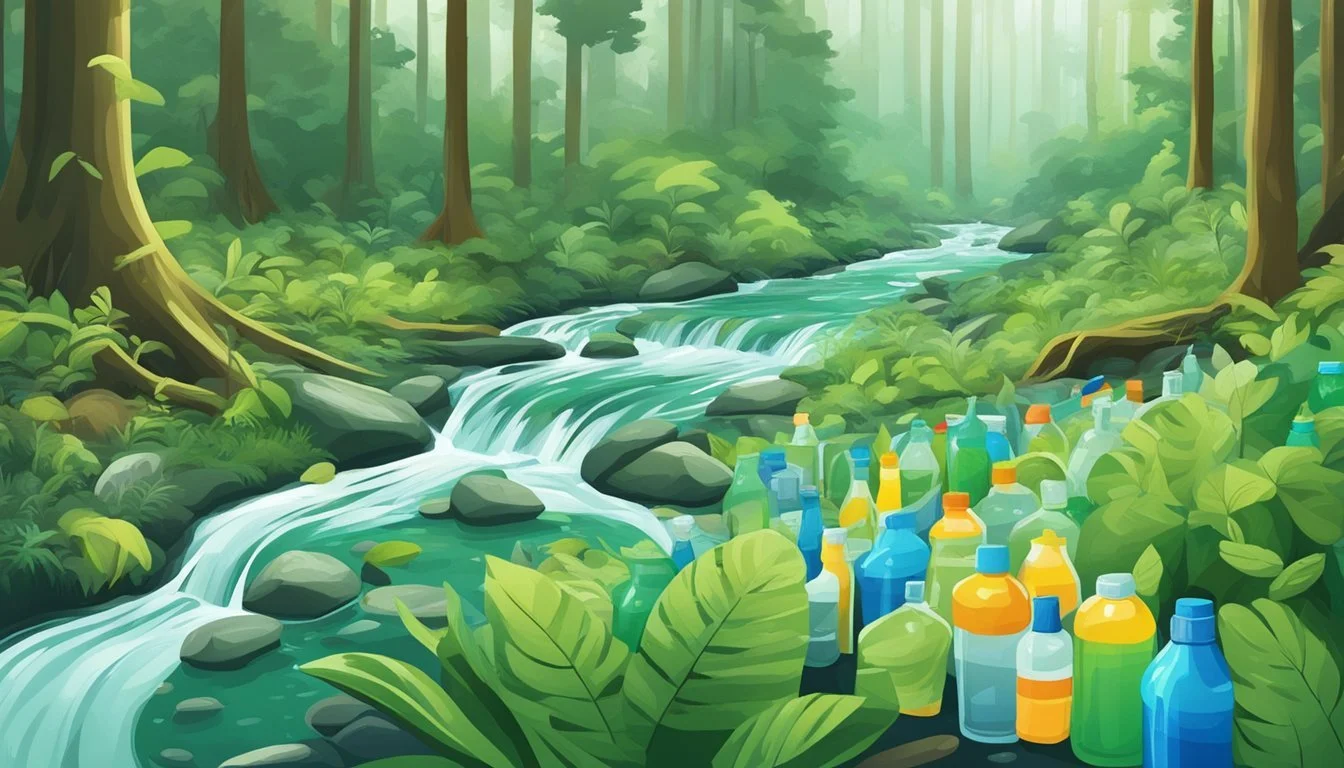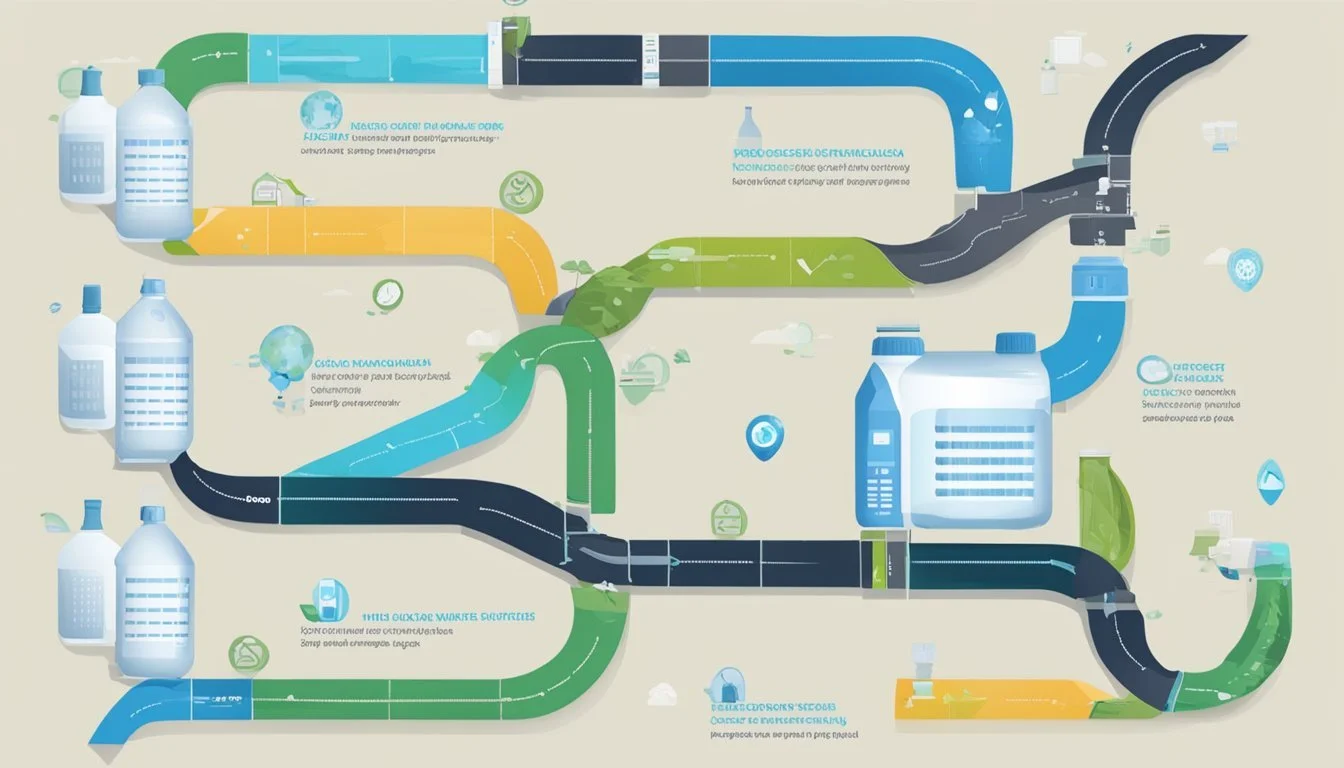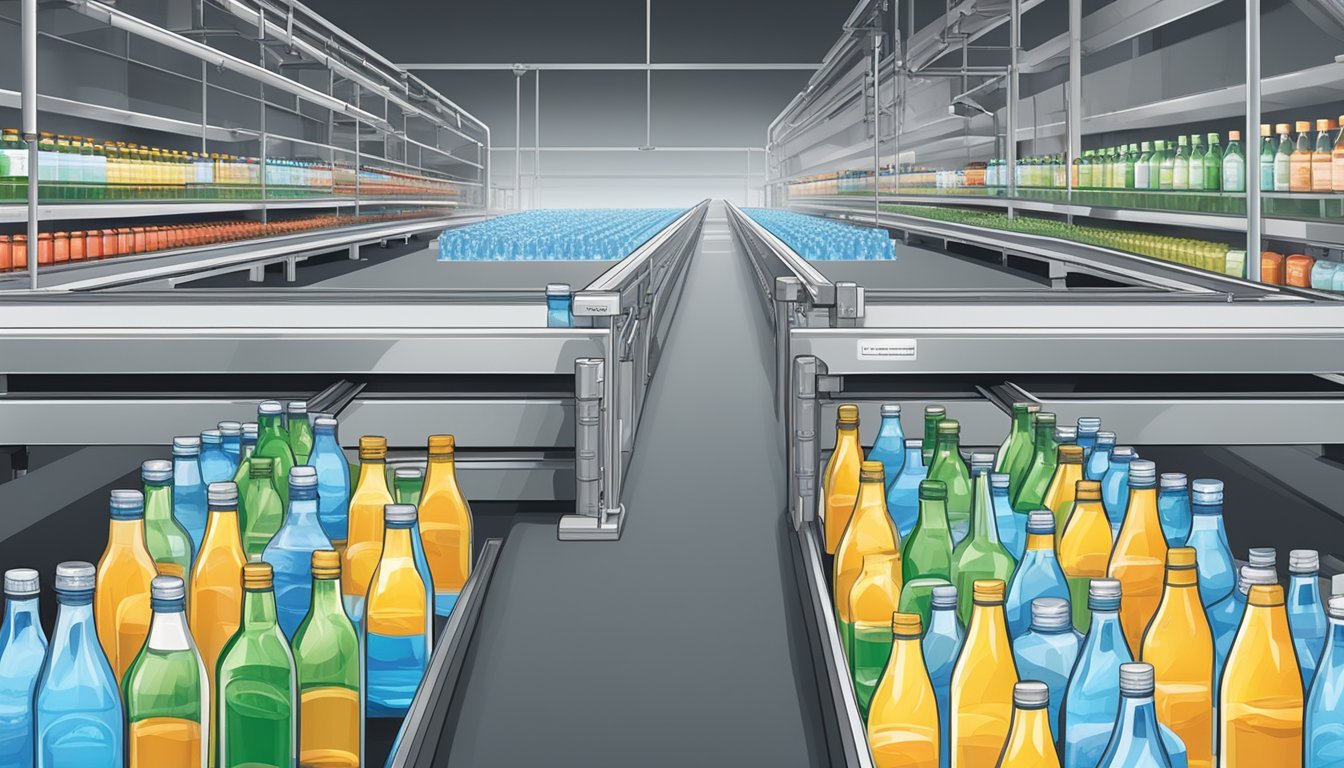Path vs. Blk
Comparing Bottled Water Quality and Benefits
When it comes to bottled water, two brands that have garnered attention are PATH and blk. These brands stand out not just for their function but also for their innovative takes on hydration. PATH offers a sustainable solution with its refillable aluminum bottles, aiming to reduce single-use plastic pollution. Its purified water maintains simplicity and environmental consciousness.
In contrast, blk. water catches the eye with its deep black color, infused with fulvic trace minerals. This unique composition claims to provide potential health benefits, setting it apart from the clear, conventional bottled waters. The intriguing appearance of blk. water leads many to question its taste and effectiveness.
For those seeking a sustainable option, PATH may be the better choice due to its reusable container. However, those interested in trying a more exotic and potentially beneficial hydration source might find blk. water appealing. Both brands cater to different aspects of consumer needs, offering unique experiences in the bottled water market.
Understanding Bottled Water
Bottled water comes in various forms, each offering distinct characteristics. Regulations ensure its safety, and a comparison to tap water highlights differences in cost and quality.
Types of Bottled Water
Natural Spring Water: This type is sourced from natural springs and contains various minerals. It is often marketed for its purity and taste.
Purified Water: Made by removing impurities from the source water, including tap water. This type often undergoes processes like distillation or reverse osmosis.
Alkaline Water: Known for its higher pH level, this water type is believed by some to offer health benefits such as improved hydration.
Mineral Water: Contains naturally occurring minerals and is sourced from mineral springs. The mineral content can vary significantly depending on the source.
Each type offers unique features, catering to specific consumer preferences.
Regulations and Safety
The FDA (Food and Drug Administration) regulates bottled water in the United States, ensuring it meets specific safety standards.
EPA (Environmental Protection Agency) oversees tap water quality, holding it to stringent safety criteria. Bottled water must be processed and packaged under sanitary conditions, and labels must accurately reflect contents.
Both bottled and tap water have to comply with maximum contaminant levels for various substances. While bottled water is generally considered safe, it is essential to verify the source and type to understand specific benefits and potential drawbacks.
Comparing Bottled Water to Tap Water
Cost Comparison: Tap water is significantly cheaper, costing roughly $0.005 per gallon. In contrast, bottled water can cost around $9.47 per gallon when sourced from single-serving bottles.
Environmental Impact: Bottled water has a substantial environmental footprint due to plastic waste and transportation emissions. Tap water, being locally sourced, has a lower environmental impact.
Taste and Purity: Some consumers prefer the taste of bottled water. Purified options offer consistent quality, while tap water can vary by location. Filtration systems for tap water present a cost-effective alternative to bottled water for added purity.
Evaluating these aspects helps consumers make informed choices based on cost, environmental concerns, and personal preferences.
Brand Profiles
Path and Blk are two bottled water brands that cater to different market segments. This section explores each brand’s unique characteristics and also touches on how they stack up against other popular brands.
Path Water Overview
Path positions itself as an eco-friendly choice, providing reusable aluminum bottles. They aim to reduce single-use plastic waste with their sleek, durable containers.
Their water is purified through reverse osmosis, and the brand emphasizes sustainability through refill stations. Path appeals to environmentally conscious consumers looking for a high-quality product that also addresses environmental concerns.
Despite the higher initial cost, the value proposition includes the reusability factor, which differentiates Path from traditional bottled water brands like Evian or Fiji.
Blk Water Overview
Blk Water stands out for its distinctive black color, attributed to fulvic minerals infused in the water. It’s marketed as a premium, high-mineral-content beverage, and positioned at a higher price point than standard bottled waters.
The inclusion of fulvic trace minerals not only gives it its unique hue but also claims to provide additional health benefits. The brand targets niche markets interested in novel products and potential health enhancements.
Unlike conventional waters such as Smartwater or Icelandic Glacial, Blk offers a visual and functional novelty that intrigues consumers.
Market Competitors
Both Path and Blk find themselves competing with several well-known bottled water brands. Competitors like Acqua Panna and Arrowhead focus on purity and taste.
Brands like Evian and Fiji emphasize natural sources and premium quality. Smartwater offers a science-backed approach with added electrolytes, while Icelandic Glacial boasts of exceptional purity from natural springs.
Each brand provides unique selling points, whether it’s sustainability, mineral content, or purity, making the bottled water market diverse and competitive.
Health and Hydration
Hydration and water quality are essential for maintaining optimal health. This section focuses on the key factors that distinguish Path and Blk bottled water brands in terms of their health benefits and hydration efficacy.
Importance of Hydration
Proper hydration is critical for bodily functions such as temperature regulation, joint lubrication, and waste elimination. Path and Blk both aim to provide effective hydration, but they approach this goal differently.
Path Water is sourced from natural springs, guaranteeing pure and safe drinking water. Its mineral profile supports hydration and overall well-being.
Blk Water infuses fulvic trace minerals, which may enhance nutrient absorption. These minerals give the water a dark, distinctive hue and could potentially provide additional health benefits.
Hydration is not just about quenching thirst; it’s about ensuring the body functions efficiently. Both brands seek to achieve this through their unique formulations.
Water Quality and Health Benefits
Water quality directly impacts health by influencing hydration levels, pH balance, and mineral intake. Path and Blk are both marketed with health benefits in mind.
Path Water offers a balanced pH, which is beneficial for maintaining the body's natural pH levels. This can contribute to better liver function and overall metabolic processes. Path's bottles are BPA-free, adding an extra layer of safety.
Blk Water stands out due to its high fulvic acid content, providing trace minerals that support cellular health. Its dark color is due to these minerals, which might also aid in detoxifying the body.
Mineral content and safety standards are crucial aspects of safe drinking water. Both Path and Blk are committed to ensuring their products meet high quality and safety standards, making them reliable choices for health-conscious consumers.
Environmental Impact
Evaluating the environmental impact of Path and Blk bottled water involves examining their use of plastics, sustainability initiatives, and alternatives like reusable bottles. Understanding these factors can help consumers make environmentally conscious choices.
Plastic Crisis and Alternatives
The widespread use of single-use plastic water bottles contributes significantly to plastic pollution. Production of these bottles involves large amounts of water and energy. For instance, it takes three times the water to produce a plastic bottle than it can actually hold.
Path has taken steps to address this issue by using aluminum bottles, which are recyclable and reduce plastic waste. Aluminum can be recycled indefinitely, decreasing the pressure on landfills. On the other hand, Blk uses conventional plastic bottles, which may not be as environmentally friendly.
Efforts to find biodegradable alternatives are ongoing. Materials like plant-based plastics and recycled plastics are gaining attention, but they still need wider adoption and consumer acceptance.
Sustainability Initiatives
Sustainability is a key focus for both brands, but their approaches differ. Path focuses on creating a closed-loop system where bottles are made from recycled aluminum and can be continually recycled. This approach significantly reduces waste and conserves natural resources.
Blk engages in various sustainability initiatives, including partial use of recycled plastics in their bottles. They also invest in projects aimed at reducing their carbon footprint. However, their reliance on plastic means their environmental impact remains higher compared to aluminum alternatives.
Both brands participate in community education programs to promote recycling and responsible consumption practices. These efforts help raise awareness and encourage more sustainable choices among consumers.
Reusable Bottle Solutions
Moving toward reusable bottles is an effective way to combat the environmental impact of bottled water. Path offers robust, reusable aluminum bottles designed for long-term use. These bottles not only reduce plastic pollution but also encourage consumers to refill instead of buying new single-use bottles.
Blk doesn’t specifically emphasize reusable bottle solutions, focusing instead on improving the recyclability of their current plastic packaging. While this is a step in the right direction, promoting reusable options could further enhance their environmental credentials.
Ultimately, adopting reusable bottles can significantly reduce single-use plastic pollution and support a more sustainable planet.
Taste and Aesthetics
When comparing Path and blk. bottled water, factors such as taste and aesthetics play significant roles. These elements influence consumer preferences and overall drinking experience.
The Role of Taste in Water Selection
Taste is a defining characteristic for many bottled water drinkers. Path water is often described as having a clean, crisp flavor due to its filtration process. On the other hand, blk. water is noted for its neutral or very subtle taste, attributed to the presence of fulvic minerals.
Water sommeliers often highlight how fulvic minerals give blk. water a mild earthiness. Taste tests frequently show a preference for Path's conventional taste, though blk.'s unique properties appeal to those looking for something different. Understanding these nuances helps consumers make informed choices based on their taste preferences.
Packaging and Design
Examining the packaging and design choices of Path and Blk reveals significant differences in materials, sustainability, and aesthetics. These aspects are crucial for both environmental impact and customer experience.
Bottle Materials and Types
Path water bottles are crafted from 100% aluminum. This material choice allows the bottles to be infinitely recyclable and highly durable. Aluminum is a superior option for sustainability as it can be reused effectively. Path’s bottles are designed for reusability, reducing reliance on single-use plastics.
Blk, on the other hand, utilizes PET plastic for their bottles. PET plastic is recyclable but less durable compared to aluminum. Blk's bottles do feature a sleek, black design, aligning with their brand's aesthetic of minimalism and modernity.
Lifestyle and Convenience
When comparing Path and Blk bottled water, both brands offer unique benefits regarding lifestyle and convenience. These aspects are crucial for consumers seeking hydration options that fit seamlessly into their busy lives.
Water on the Go
For individuals who are constantly on the move, having access to portable and efficient hydration is essential. Path water bottles stand out due to their refillable aluminum design, which is both environmentally friendly and durable. This feature makes them a reliable choice for people who want to reduce plastic waste while maintaining a convenient and reusable option.
In contrast, Blk water bottles, with their sleek black appearance, appeal to those who prefer a fashionable and interesting choice. Though not specifically designed for refilling, Blk's unique aesthetic and potential health benefits deliver a stylish accessory for daily hydration.
Accessibility and Availability
Path bottled water can typically be found in major grocery stores and retailers, making it easily accessible for regular purchases. Their commitment to sustainability resonates well with eco-conscious consumers, adding another layer of appeal. The wide distribution network ensures that Path water remains a convenient option for those looking to make environmentally responsible choices.
Blk water, on the other hand, is often available in specialty health stores and online platforms. Its striking black color and claims of enriched minerals make it an intriguing option. Its presence in selective markets adds a layer of exclusivity, appealing to those who enjoy unique products. However, this can sometimes limit its availability in more conventional shopping venues.
Both Path and Blk bottled waters provide distinct advantages, catering to various lifestyle needs and preferences.
Cost Analysis
This section analyzes the cost of Path and Blk bottled water, focusing on their price points and overall value for money.
Price Comparison
Path water generally falls within the mid-range pricing category. A typical price for a 20oz bottle is around $2.50, depending on grocery stores and regional variations. In contrast, Blk. Water positions itself as a premium product with prices ranging from $2 to $4 per 16-24oz bottle.
Blk. Water's premium price can be attributed to its unique feature, the infusion of fulvic minerals, which gives it a distinctive black hue. The higher price tag often translates to a 300% markup compared to mainstream brands like Poland Spring.
Assessing Value for Money
Path Water:
Offers a reusable aluminum bottle.
Positioned within a sustainable market segment.
Priced competitively for environmentally-conscious consumers.
Blk. Water:
Infused with fulvic minerals.
Claims potential health benefits and unique appearance.
Higher premium may give buyers a sense of exclusive quality.
When assessing value, Path's reusable bottles may appeal more to eco-friendly consumers willing to invest in a product that offers sustainability and cost-effectiveness over time. Conversely, Blk.'s unique selling proposition lies in its potential health benefits and distinct appearance, justifying its higher price for those seeking these specific features.
Both brands clearly target different market segments, making each appealing in its own unique way based on consumer priorities.
Quality Control and Assurance
Ensuring the quality of Path and Blk bottled waters involves adhering to stringent standards and rigorous testing to ensure safety and reliability for consumers. Key aspects include maintaining high quality standards and conducting comprehensive water testing.
Quality Standards
Both Path and Blk bottled waters follow strict quality standards. Path bottled water sources from municipal water supplies, ensuring compliance with local and federal regulations. These standards mandate regular monitoring for contaminants, including heavy metals.
Blk water, known for its unique fulvic trace minerals, also adheres to high-quality protocols. Compliance with international quality standards is crucial, given its distinct composition. Ensuring consistent quality and safety helps build consumer trust.
Regulatory bodies, such as the FDA in the United States, oversee the bottled water industry's compliance, guaranteeing public health protection. Both brands must regularly document their adherence to these stringent guidelines to remain compliant and competitive in the market.
Water Testing and Safety
Routine and rigorous testing is fundamental for ensuring bottled water safety. Path water undergoes frequent testing to detect contaminants like heavy metals, pesticides, and microbial contaminants. Advanced filtration systems and purification processes are used to remove impurities and enhance water quality.
Blk water, with its unique mineral infusion, is similarly tested for its distinct composition. Tests ensure that fulvic trace minerals and other components meet health and safety standards. This includes monitoring for contaminants that could affect its safety or quality.
State-of-the-art laboratories conduct these tests, employing methods such as spectrometry and chromatography. These tests ensure that any potential contaminants are identified and eradicated, maintaining the highest water quality for consumers.
More About Path
Mountain Valley Spring Water vs Path: Which Bottled Water is Better?
Path vs Whole Foods Italian Still Mineral water: Which Bottled Water is Better?







